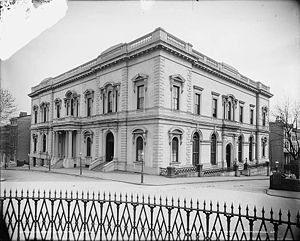Asger Hamerik: Requiem (1887)
 |
| Dansk: Billede af den danske kompopnist Asger Hamerik som yngre (Photo credit: Wikipedia) |
II. Dies Irae - 9:07
III. Offetorium - 26:08
IV. Sanctus - 32:13
V. Agnus Dei - 36:19
When the Peabody Institute closed for the summer, Hamerik would escape from warm, damp Baltimore to the far more pleasant climate of the small fishing village of Chester on the Atlantic coast of Nova Scotia, Canada, where he also found the time to compose. At intervals - but far from every year - he also took the long journey home to Denmark, with which he otherwise only maintained contact by letter. So it was in a letter - but from New York - that he announced in 1894 to his Danish family that after many years as a bachelor, he had married a former piano pupil from the Peabody Institute: "Today, 5th June, I have married Margaret Williams, daughter of a landowner in the southern state of Tennessee, descended on her mother's side from the English Duke of Wharton. She is 26 years old, of medium height, slender with bright eyes and light chestnut brown hair, of a mild and gentle nature with harmony of mind and firmness of character."
 |
| Peabody Institute, Baltimore (Photo credit: Wikipedia) |
new member before the couple went back to Baltimore, where the Peabody Institute was to celebrate the centenary of the birth of its founder in 1895. As far as the music was concerned, the choice was made to have Hamerik premiere his opus 34, a Requiem which he had composed in the summers of 1886 and 1887 in Chester, and which his brother, Angul Hammerich, a music professor and critic had tried in vain to coax the Chorus of the Royal Opera in Copenhagen to premiere in its annual Easter concert in Copenhagen Cathedral.
The Requiem therefore lay idle awaiting a suitable occasion, and this now came, with two magnificent concerts on 5th and 6th April. The choir had more than 300 singers, and the work was given more than 60 rehearsals. The contralto soloist, Julie Wynan, had been fetched from New York, and the success of the work was huge - The Baltimore Sun wrote that the music was "of overwhelming beauty".
Certainly Hamerik himself was not a Catholic, but he was a close friend of Cardinal Gibbons in Baltimore and is also known to have had discussions with a Catholic priest in Chester about the textual content and its meaning. As Berlioz had done a half-century before in his Requiem, Hamerik combined the first two parts of the Mass for the dead, the Requiem aeternam and the Kyrie eleison, into one movement where the quiet C minor prayer for eternal peace yields to C major wish for eternal light. The subsequent Dies irae quotes the first notes of the old Gregorian melody of the text about the Day of Wrath, just as Berlioz had done (in his Symphonie fantastique). In the Tuba mirum, Judgement Day is announced with ringing brass fanfares in andante maestoso, again like Berlioz. But unlike his mentor Hamerik creates a new continuity by making these fanfares a recurrent orchestral element in the Sanctus movement.
The intervening Offertorio brings the contralto soloist to the fore, and she appears again in the concluding Agnus Dei, now also with the choir. The cyclic form of the text (it returns to the introductory section) is also reflected in the music, in the same way as we see in Mozart (or his 'completer', Süssmayr) and Berlioz. The first performance of the Requiem in Baltimore prompted very fine reactions from the press, and Hamerik was pleased with his collaboration with the director of the local Oratorio Society, Joseph Pache, who like himself had been a pupil of von Bülow. So he said yes when he was asked for a new work for choir and orchestra, for which he wrote the text together with his young wife at the end of 1897 and then composed in January-February 1898.
The Requiem remained Hamerik's own favourite work, and he made sure he included the Offertory movement in the above-mentioned presentation concerts, where it elicited positive comments from all sides: "Belle et émouvante" (beautiful and moving) said Le Figaro. "Eine echte Kirchen-musik" (a true work of sacred music) wrote Wiener Sonntagszeitung, although the concert in Vienna was held in the citadel of secular music, the Golden Hall of the Musikverein, where the reception after the concert glittered with celebrated names like the soprano Nellie Melba. And "classically weighty" was the judgement that could be read in the Danish newspaper Politiken, which had considered the tour important enough to send its reviewer Charles Kjerulf to Berlin.

